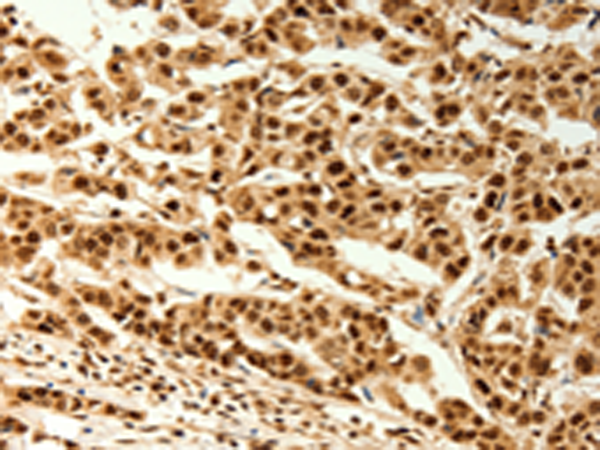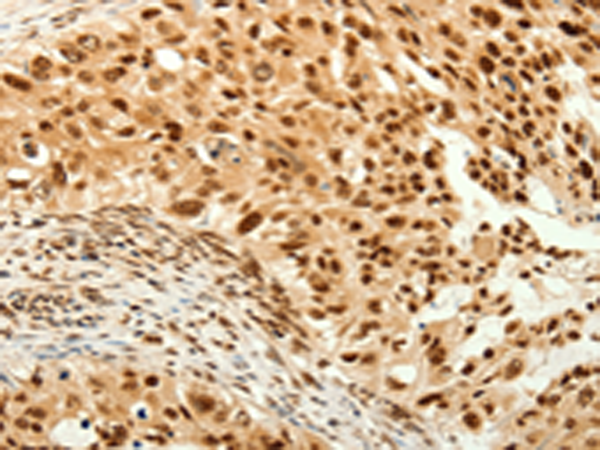


| WB | 咨询技术 | Human,Mouse,Rat |
| IF | 咨询技术 | Human,Mouse,Rat |
| IHC | 1/100-1/300 | Human,Mouse,Rat |
| ICC | 技术咨询 | Human,Mouse,Rat |
| FCM | 咨询技术 | Human,Mouse,Rat |
| Elisa | 1/1000-1/2000 | Human,Mouse,Rat |
| Aliases | FR2BP; C12orf5 |
| WB Predicted band size | 30 kDa |
| Host/Isotype | Rabbit IgG |
| Antibody Type | Primary antibody |
| Storage | Store at 4°C short term. Aliquot and store at -20°C long term. Avoid freeze/thaw cycles. |
| Species Reactivity | Human |
| Immunogen | Synthetic peptide of human TIGAR |
| Formulation | Purified antibody in PBS with 0.05% sodium azide and 50% glycerol. |
+ +
以下是3篇与TIGAR抗体相关的文献摘要信息(示例基于真实研究,具体文献需根据实际数据库检索验证):
1. **文献名称**:*TIGAR, a p53-Inducible Regulator of Glycolysis and Apoptosis*
**作者**:Bensaad K, et al.
**摘要**:该研究首次报道TIGAR蛋白通过抑制糖酵解和促进PPP途径调控细胞能量代谢,研究中使用特异性TIGAR抗体验证其在p53通路中的表达及功能,揭示其在氧化应激中的保护作用。
2. **文献名称**:*TIGAR promotes tumor progression by regulating cancer metabolism in colorectal cancer*
**作者**:Cheung EC, et al.
**摘要**:通过TIGAR抗体的免疫组化分析,研究发现结直肠癌中TIGAR高表达与患者预后不良相关,其机制涉及增强NADPH生成以抵抗氧化应激并促进肿瘤存活。
3. **文献名称**:*TIGAR Deficiency Enhances Neuronal Apoptosis after Hypoxic-Ischemic Injury*
**作者**:Li M, et al.
**摘要**:利用TIGAR敲除小鼠及抗体检测,证明TIGAR通过调控线粒体功能减少缺氧缺血后的神经元凋亡,提示其在神经系统损伤中的保护作用。
(注:以上为示例性内容,实际文献需通过PubMed/Google Scholar检索关键词“TIGAR antibody”或“TIGAR function”获取准确信息。)
The TIGAR (TP53-induced glycolysis and apoptosis regulator) antibody is a critical tool for studying the role of TIGAR, a p53-inducible protein that regulates cellular energy metabolism and apoptosis. TIGAR functions primarily by suppressing glycolysis and promoting the pentose phosphate pathway (PPP), thereby reducing reactive oxygen species (ROS) levels and enhancing cell survival under stress. Discovered in 2006. TIGAR’s dual role in both promoting cell survival (via ROS scavenging) and potentially contributing to tumor progression has made it a focus in cancer biology, neurodegenerative diseases, and ischemia-reperfusion injury research.
Antibodies targeting TIGAR are widely used to detect its expression, localization, and interactions in various experimental models, including Western blotting, immunohistochemistry, and immunofluorescence. Given TIGAR’s context-dependent roles—acting as a tumor suppressor in some settings and supporting tumor growth in others—specific and validated antibodies are essential for accurate research. Commercial TIGAR antibodies are typically raised against specific epitopes in human or murine TIGAR, with validation in knockout/knockdown controls to ensure specificity. Researchers rely on these antibodies to explore TIGAR’s regulatory mechanisms, its interplay with p53. and its therapeutic potential in diseases linked to metabolic dysregulation or oxidative stress.
×